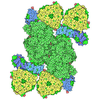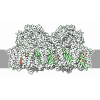[English] 日本語
 Yorodumi
Yorodumi- PDB-8eqm: Structure of a dimeric photosystem II complex acclimated to far-r... -
+ Open data
Open data
- Basic information
Basic information
| Entry | Database: PDB / ID: 8eqm | ||||||||||||
|---|---|---|---|---|---|---|---|---|---|---|---|---|---|
| Title | Structure of a dimeric photosystem II complex acclimated to far-red light | ||||||||||||
 Components Components |
| ||||||||||||
 Keywords Keywords | PHOTOSYNTHESIS / Far-red / photosystem II / cyanobacteria / chlorophyll | ||||||||||||
| Function / homology |  Function and homology information Function and homology informationphotosystem II oxygen evolving complex / photosystem II assembly / oxygen evolving activity / photosystem II stabilization / photosystem II reaction center / photosystem II / photosynthetic electron transport chain / photosystem II / extrinsic component of membrane / chlorophyll binding ...photosystem II oxygen evolving complex / photosystem II assembly / oxygen evolving activity / photosystem II stabilization / photosystem II reaction center / photosystem II / photosynthetic electron transport chain / photosystem II / extrinsic component of membrane / chlorophyll binding / plasma membrane-derived thylakoid membrane / photosynthetic electron transport in photosystem II / photosynthesis, light reaction / phosphate ion binding / : / photosynthesis / respiratory electron transport chain / electron transfer activity / protein stabilization / iron ion binding / heme binding / metal ion binding Similarity search - Function | ||||||||||||
| Biological species |  Synechococcus sp. PCC 7335 (bacteria) Synechococcus sp. PCC 7335 (bacteria) | ||||||||||||
| Method | ELECTRON MICROSCOPY / single particle reconstruction / cryo EM / Resolution: 2.6 Å | ||||||||||||
 Authors Authors | Gisriel, C.J. / Shen, G. / Flesher, D.A. / Kurashov, V. / Golbeck, J.H. / Brudvig, G.W. / Amin, M. / Bryant, D.A. | ||||||||||||
| Funding support |  United States, 3items United States, 3items
| ||||||||||||
 Citation Citation |  Journal: J Biol Chem / Year: 2023 Journal: J Biol Chem / Year: 2023Title: Structure of a dimeric photosystem II complex from a cyanobacterium acclimated to far-red light. Authors: Christopher J Gisriel / Gaozhong Shen / David A Flesher / Vasily Kurashov / John H Golbeck / Gary W Brudvig / Muhamed Amin / Donald A Bryant /   Abstract: Photosystem II (PSII) is the water-splitting enzyme central to oxygenic photosynthesis. To drive water oxidation, light is harvested by accessory pigments, mostly chlorophyll (Chl) a molecules, which ...Photosystem II (PSII) is the water-splitting enzyme central to oxygenic photosynthesis. To drive water oxidation, light is harvested by accessory pigments, mostly chlorophyll (Chl) a molecules, which absorb visible light (400-700 nm). Some cyanobacteria facultatively acclimate to shaded environments by altering their photosynthetic machinery to additionally absorb far-red light (FRL, 700-800 nm), a process termed far-red light photoacclimation or FaRLiP. During far-red light photoacclimation, FRL-PSII is assembled with FRL-specific isoforms of the subunits PsbA, PsbB, PsbC, PsbD, and PsbH, and some Chl-binding sites contain Chls d or f instead of the usual Chl a. The structure of an apo-FRL-PSII monomer lacking the FRL-specific PsbH subunit has previously been determined, but visualization of the dimeric complex has remained elusive. Here, we report the cryo-EM structure of a dimeric FRL-PSII complex. The site assignments for Chls d and f are consistent with those assigned in the previous apo-FRL-PSII monomeric structure. All sites that bind Chl d or Chl f at high occupancy exhibit a FRL-specific interaction of the formyl moiety of the Chl d or Chl f with the protein environment, which in some cases involves a phenylalanine sidechain. The structure retains the FRL-specific PsbH2 subunit, which appears to alter the energetic landscape of FRL-PSII, redirecting energy transfer from the phycobiliprotein complex to a Chl f molecule bound by PsbB2 that acts as a bridge for energy transfer to the electron transfer chain. Collectively, these observations extend our previous understanding of the structure-function relationship that allows PSII to function using lower energy FRL. | ||||||||||||
| History |
|
- Structure visualization
Structure visualization
| Structure viewer | Molecule:  Molmil Molmil Jmol/JSmol Jmol/JSmol |
|---|
- Downloads & links
Downloads & links
- Download
Download
| PDBx/mmCIF format |  8eqm.cif.gz 8eqm.cif.gz | 970.8 KB | Display |  PDBx/mmCIF format PDBx/mmCIF format |
|---|---|---|---|---|
| PDB format |  pdb8eqm.ent.gz pdb8eqm.ent.gz | 805.3 KB | Display |  PDB format PDB format |
| PDBx/mmJSON format |  8eqm.json.gz 8eqm.json.gz | Tree view |  PDBx/mmJSON format PDBx/mmJSON format | |
| Others |  Other downloads Other downloads |
-Validation report
| Summary document |  8eqm_validation.pdf.gz 8eqm_validation.pdf.gz | 6.3 MB | Display |  wwPDB validaton report wwPDB validaton report |
|---|---|---|---|---|
| Full document |  8eqm_full_validation.pdf.gz 8eqm_full_validation.pdf.gz | 6.8 MB | Display | |
| Data in XML |  8eqm_validation.xml.gz 8eqm_validation.xml.gz | 214 KB | Display | |
| Data in CIF |  8eqm_validation.cif.gz 8eqm_validation.cif.gz | 283.4 KB | Display | |
| Arichive directory |  https://data.pdbj.org/pub/pdb/validation_reports/eq/8eqm https://data.pdbj.org/pub/pdb/validation_reports/eq/8eqm ftp://data.pdbj.org/pub/pdb/validation_reports/eq/8eqm ftp://data.pdbj.org/pub/pdb/validation_reports/eq/8eqm | HTTPS FTP |
-Related structure data
| Related structure data |  28539MC M: map data used to model this data C: citing same article ( |
|---|---|
| Similar structure data | Similarity search - Function & homology  F&H Search F&H Search |
- Links
Links
- Assembly
Assembly
| Deposited unit | 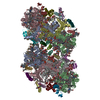
|
|---|---|
| 1 |
|
- Components
Components
-Photosystem II ... , 13 types, 26 molecules AaBbCcDdHhIiKkLlMmOoTtUuXx
| #1: Protein | Mass: 39958.668 Da / Num. of mol.: 2 / Source method: isolated from a natural source / Source: (natural)  Synechococcus sp. PCC 7335 (bacteria) / Strain: ATCC 29403 / PCC 7335 Synechococcus sp. PCC 7335 (bacteria) / Strain: ATCC 29403 / PCC 7335#2: Protein | Mass: 56440.980 Da / Num. of mol.: 2 / Source method: isolated from a natural source / Source: (natural)  Synechococcus sp. PCC 7335 (bacteria) / Strain: ATCC 29403 / PCC 7335 / References: UniProt: B4WKI1 Synechococcus sp. PCC 7335 (bacteria) / Strain: ATCC 29403 / PCC 7335 / References: UniProt: B4WKI1#3: Protein | Mass: 52375.664 Da / Num. of mol.: 2 / Source method: isolated from a natural source / Source: (natural)  Synechococcus sp. PCC 7335 (bacteria) / Strain: ATCC 29403 / PCC 7335 / References: UniProt: B4WKI2 Synechococcus sp. PCC 7335 (bacteria) / Strain: ATCC 29403 / PCC 7335 / References: UniProt: B4WKI2#4: Protein | Mass: 39596.496 Da / Num. of mol.: 2 / Source method: isolated from a natural source / Source: (natural)  Synechococcus sp. PCC 7335 (bacteria) / Strain: ATCC 29403 / PCC 7335 / References: UniProt: B4WKI3 Synechococcus sp. PCC 7335 (bacteria) / Strain: ATCC 29403 / PCC 7335 / References: UniProt: B4WKI3#7: Protein | Mass: 7247.715 Da / Num. of mol.: 2 / Source method: isolated from a natural source / Source: (natural)  Synechococcus sp. PCC 7335 (bacteria) / Strain: ATCC 29403 / PCC 7335 / References: UniProt: B4WKI0 Synechococcus sp. PCC 7335 (bacteria) / Strain: ATCC 29403 / PCC 7335 / References: UniProt: B4WKI0#8: Protein/peptide | Mass: 4229.917 Da / Num. of mol.: 2 / Source method: isolated from a natural source / Source: (natural)  Synechococcus sp. PCC 7335 (bacteria) / Strain: ATCC 29403 / PCC 7335 / References: UniProt: B4WM03 Synechococcus sp. PCC 7335 (bacteria) / Strain: ATCC 29403 / PCC 7335 / References: UniProt: B4WM03#9: Protein/peptide | Mass: 5069.053 Da / Num. of mol.: 2 / Source method: isolated from a natural source / Source: (natural)  Synechococcus sp. PCC 7335 (bacteria) / Strain: ATCC 29403 / PCC 7335 / References: UniProt: B4WR12 Synechococcus sp. PCC 7335 (bacteria) / Strain: ATCC 29403 / PCC 7335 / References: UniProt: B4WR12#10: Protein/peptide | Mass: 4566.261 Da / Num. of mol.: 2 / Source method: isolated from a natural source / Source: (natural)  Synechococcus sp. PCC 7335 (bacteria) / Strain: ATCC 29403 / PCC 7335 / References: UniProt: B4WII3 Synechococcus sp. PCC 7335 (bacteria) / Strain: ATCC 29403 / PCC 7335 / References: UniProt: B4WII3#11: Protein/peptide | Mass: 3980.772 Da / Num. of mol.: 2 / Source method: isolated from a natural source / Source: (natural)  Synechococcus sp. PCC 7335 (bacteria) / Strain: ATCC 29403 / PCC 7335 Synechococcus sp. PCC 7335 (bacteria) / Strain: ATCC 29403 / PCC 7335#12: Protein | Mass: 29319.096 Da / Num. of mol.: 2 / Source method: isolated from a natural source / Source: (natural)  Synechococcus sp. PCC 7335 (bacteria) / Strain: ATCC 29403 / PCC 7335 / References: UniProt: B4WKJ1 Synechococcus sp. PCC 7335 (bacteria) / Strain: ATCC 29403 / PCC 7335 / References: UniProt: B4WKJ1#13: Protein/peptide | Mass: 3606.362 Da / Num. of mol.: 2 / Source method: isolated from a natural source / Source: (natural)  Synechococcus sp. PCC 7335 (bacteria) / Strain: ATCC 29403 / PCC 7335 / References: UniProt: A0A2W4UG77 Synechococcus sp. PCC 7335 (bacteria) / Strain: ATCC 29403 / PCC 7335 / References: UniProt: A0A2W4UG77#14: Protein | Mass: 17325.834 Da / Num. of mol.: 2 / Source method: isolated from a natural source / Source: (natural)  Synechococcus sp. PCC 7335 (bacteria) / Strain: ATCC 29403 / PCC 7335 / References: UniProt: B4WMT5 Synechococcus sp. PCC 7335 (bacteria) / Strain: ATCC 29403 / PCC 7335 / References: UniProt: B4WMT5#16: Protein/peptide | Mass: 4273.182 Da / Num. of mol.: 2 / Source method: isolated from a natural source / Source: (natural)  Synechococcus sp. PCC 7335 (bacteria) / Strain: ATCC 29403 / PCC 7335 / References: UniProt: B4WIZ7 Synechococcus sp. PCC 7335 (bacteria) / Strain: ATCC 29403 / PCC 7335 / References: UniProt: B4WIZ7 |
|---|
-Cytochrome b559 subunit ... , 2 types, 4 molecules EeFf
| #5: Protein | Mass: 9136.276 Da / Num. of mol.: 2 / Source method: isolated from a natural source / Source: (natural)  Synechococcus sp. PCC 7335 (bacteria) / Strain: ATCC 29403 / PCC 7335 / References: UniProt: B4WII1 Synechococcus sp. PCC 7335 (bacteria) / Strain: ATCC 29403 / PCC 7335 / References: UniProt: B4WII1#6: Protein/peptide | Mass: 5023.960 Da / Num. of mol.: 2 / Source method: isolated from a natural source / Source: (natural)  Synechococcus sp. PCC 7335 (bacteria) / Strain: ATCC 29403 / PCC 7335 / References: UniProt: B4WKJ2 Synechococcus sp. PCC 7335 (bacteria) / Strain: ATCC 29403 / PCC 7335 / References: UniProt: B4WKJ2 |
|---|
-Protein , 1 types, 2 molecules Vv
| #15: Protein | Mass: 18814.387 Da / Num. of mol.: 2 / Source method: isolated from a natural source / Source: (natural)  Synechococcus sp. PCC 7335 (bacteria) / Strain: ATCC 29403 / PCC 7335 / References: UniProt: B4WI32 Synechococcus sp. PCC 7335 (bacteria) / Strain: ATCC 29403 / PCC 7335 / References: UniProt: B4WI32 |
|---|
-Sugars , 2 types, 8 molecules 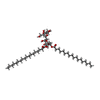
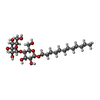

| #28: Sugar | ChemComp-DGD / #33: Sugar | |
|---|
-Non-polymers , 16 types, 714 molecules 


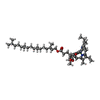

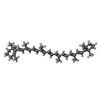
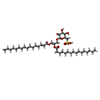
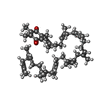
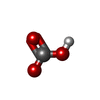
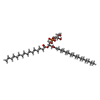
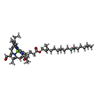
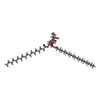

















| #17: Chemical | | #18: Chemical | #19: Chemical | ChemComp-CL / #20: Chemical | ChemComp-CLA / #21: Chemical | ChemComp-PHO / #22: Chemical | ChemComp-BCR / #23: Chemical | ChemComp-SQD / #24: Chemical | ChemComp-PL9 / #25: Chemical | #26: Chemical | ChemComp-LHG / #27: Chemical | ChemComp-F6C /  Mass: 905.457 Da / Num. of mol.: 8 / Source method: obtained synthetically / Formula: C55H68MgN4O6 / Feature type: SUBJECT OF INVESTIGATION Mass: 905.457 Da / Num. of mol.: 8 / Source method: obtained synthetically / Formula: C55H68MgN4O6 / Feature type: SUBJECT OF INVESTIGATION#29: Chemical | #30: Chemical | ChemComp-LMG / #31: Chemical | ChemComp-HEM / #32: Chemical | #34: Water | ChemComp-HOH / | |
|---|
-Details
| Has ligand of interest | Y |
|---|---|
| Has protein modification | N |
-Experimental details
-Experiment
| Experiment | Method: ELECTRON MICROSCOPY |
|---|---|
| EM experiment | Aggregation state: PARTICLE / 3D reconstruction method: single particle reconstruction |
- Sample preparation
Sample preparation
| Component | Name: Far-red light-acclimated photosystem II / Type: COMPLEX / Entity ID: #3, #1-#2, #4-#16 / Source: NATURAL |
|---|---|
| Source (natural) | Organism:  Synechococcus sp. PCC 7335 (bacteria) Synechococcus sp. PCC 7335 (bacteria) |
| Buffer solution | pH: 6.5 |
| Specimen | Conc.: 0.65 mg/ml / Embedding applied: NO / Shadowing applied: NO / Staining applied: NO / Vitrification applied: YES |
| Vitrification | Cryogen name: ETHANE |
- Electron microscopy imaging
Electron microscopy imaging
| Experimental equipment |  Model: Titan Krios / Image courtesy: FEI Company |
|---|---|
| Microscopy | Model: FEI TITAN KRIOS |
| Electron gun | Electron source:  FIELD EMISSION GUN / Accelerating voltage: 300 kV / Illumination mode: FLOOD BEAM FIELD EMISSION GUN / Accelerating voltage: 300 kV / Illumination mode: FLOOD BEAM |
| Electron lens | Mode: BRIGHT FIELD / Nominal defocus max: 2000 nm / Nominal defocus min: 1200 nm |
| Image recording | Electron dose: 41.1 e/Å2 / Film or detector model: GATAN K3 (6k x 4k) |
- Processing
Processing
| CTF correction | Type: PHASE FLIPPING AND AMPLITUDE CORRECTION |
|---|---|
| 3D reconstruction | Resolution: 2.6 Å / Resolution method: FSC 0.143 CUT-OFF / Num. of particles: 90191 / Symmetry type: POINT |
 Movie
Movie Controller
Controller


 PDBj
PDBj